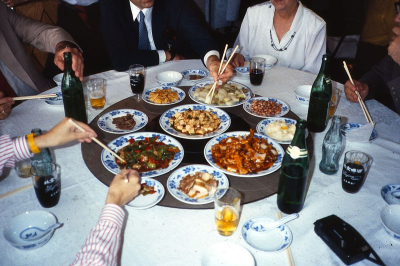What's the story behind the Lazy Susan tables?

As you and your friends are enjoying a good talk at a restaurant, they unintentionally interrupt by requesting to pass the salt. Seems like a distraction, right? The Chinese understood the assignment and designed a rotating, circular tray, usually made of wood, that was placed on a table so that people could have access to different foods with no break in the flow of the conversation. This table goes by its name, Lazy Susan.
Did you know that the original purpose of those tables was not for eating? They were, actually, used to arrange Chinese characters at printing presses - for easy access. Lazy Susan's origins can be traced back to Wang Zhen, a Chinese official who helped pioneer moveable type, in the 700-year-old Book of Agriculture, which has the earliest known description of a Chinese revolving table.
Thousands of Chinese characters needed to be arranged in order during the printing process. So, Wang Zhen decided to create a moving table, thus saving trouble for the typesetter. Wu Lien-Teh, a Chinese physician, repurposed the revolving table a.k.a. Lazy Susan, as dinner tables.
For his work, he studied several pneumonia and tuberculosis outbreaks and had developed a critical eye toward Chinese hygiene norms, particularly about eating habits. One of his articles from 1915 described group Chinese lunches as a potential source of infection and suggested a "hygienic dining tray" as a cure. A medical historian at Taiwan's Academica Sinica recently rediscovered his invention, and Wu's 1915 description was close to the Lazy Susan table.
But the name Lazy Susan' had nothing to do with Chinese cuisine because in the early 1900s, to reduce household labor during meals, these rotating tables were utilized throughout Europe and America to replace the waiters. Some historians attribute the name "Lazy Susan" to Thomas Jefferson and Thomas Edison. According to The Los Angeles Times, the two Thomases named their invention after their lazy children; nevertheless, without a piece of reliable evidence, this story is often regarded as doubtful.
The Lazy Susan phenomenon began to gain popularity in the 1900s as a significant dining item in households and Chinese-American restaurants started to feature lazy Susans regularly. With a side order of hygienic dining etiquette for which the Lazy Susan was created, it went global for its easy-to-use facility during dinner. Lazy Susan is a groundbreaking creation with a mysterious name.
Picture Credit : Google